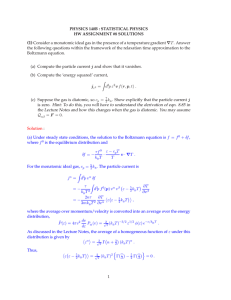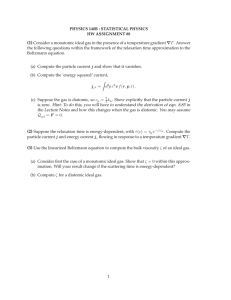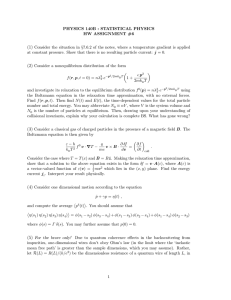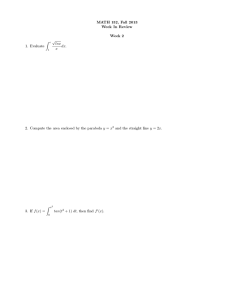8 Nonequilibrium and Transport Phenomena : Worked Examples (1)
advertisement
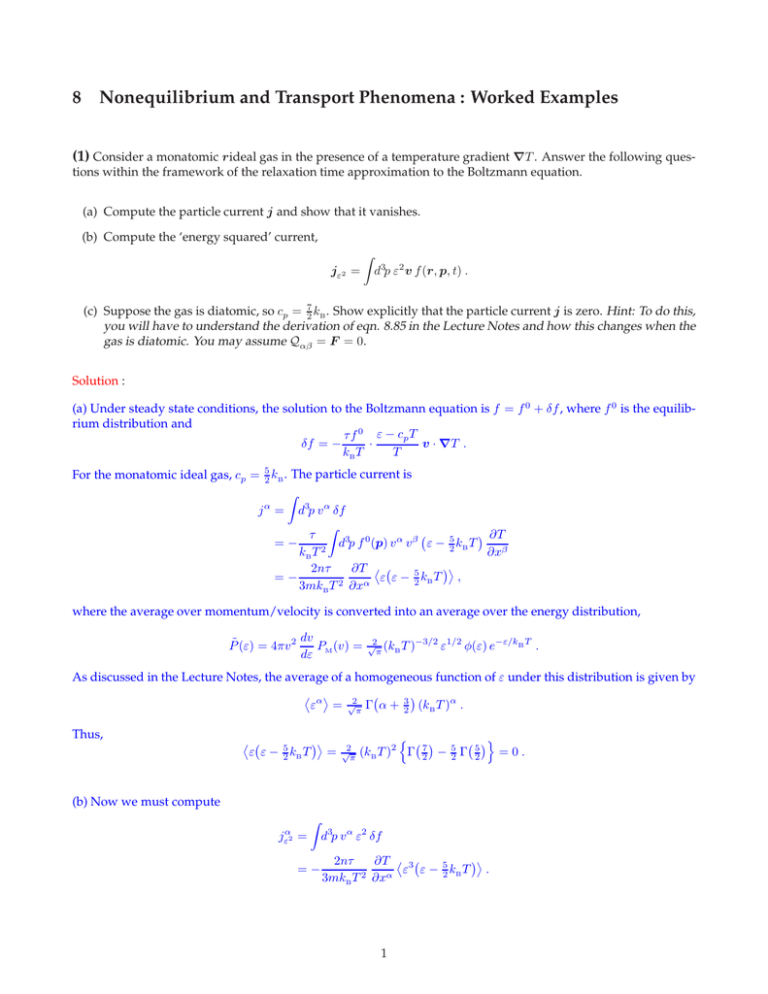
8 Nonequilibrium and Transport Phenomena : Worked Examples
(1) Consider a monatomic rideal gas in the presence of a temperature gradient ∇T . Answer the following questions within the framework of the relaxation time approximation to the Boltzmann equation.
(a) Compute the particle current j and show that it vanishes.
(b) Compute the ‘energy squared’ current,
jε2 =
Z
d3p ε2 v f (r, p, t) .
(c) Suppose the gas is diatomic, so cp = 27 kB . Show explicitly that the particle current j is zero. Hint: To do this,
you will have to understand the derivation of eqn. 8.85 in the Lecture Notes and how this changes when the
gas is diatomic. You may assume Qαβ = F = 0.
Solution :
(a) Under steady state conditions, the solution to the Boltzmann equation is f = f 0 + δf , where f 0 is the equilibrium distribution and
τ f 0 ε − cp T
·
v · ∇T .
δf = −
kB T
T
For the monatomic ideal gas, cp = 52 kB . The particle current is
Z
j α = d3p v α δf
Z
∂T
τ
=−
d3p f 0 (p) v α v β ε − 25 kB T
kB T 2
∂xβ
∂T
2nτ
ε ε − 25 kB T ,
=−
3mkB T 2 ∂xα
where the average over momentum/velocity is converted into an average over the energy distribution,
P̃ (ε) = 4πv 2
dv
P (v) =
dε M
√2 (k T )−3/2 ε1/2
B
π
φ(ε) e−ε/kB T .
As discussed in the Lecture Notes, the average of a homogeneous function of ε under this distribution is given by
α
ε = √2π Γ α + 23 (kB T )α .
Thus,
ε ε − 25 kB T =
√2
π
n
(kB T )2 Γ
7
2
−
5
2
Γ
5
2
o
(b) Now we must compute
jεα2 =
Z
=−
d3p v α ε2 δf
∂T 3
2nτ
5
k
T
.
ε
ε
−
B
2
3mkB T 2 ∂xα
1
=0.
We then have
and so
3
ε ε − 25 kB T =
√2
π
n
(kB T )4 Γ
jε2 = −
11
2
−
5
2
Γ
9
2
o
=
105
2
(kB T )4
35 nτ kB
(kB T )2 ∇T .
m
(c) For diatomic gases in the presence of a temperature gradient, the solution to the linearized Boltzmann equation
in the relaxation time approximation is
δf = −
τ f 0 ε(Γ ) − cp T
·
v · ∇T ,
kB T
T
where
L21 + L22
,
2I
where L1,2 are components of the angular momentum about the instantaneous body-fixed axes, with I ≡ I1 =
I2 ≫ I3 . We assume the rotations about axes 1 and 2 are effectively classical, so equipartition gives hεrot i =
2 × 21 kB = kB . We still have hεtr i = 23 kB . Now in the derivation of the factor ε(ε − cp T ) above, the first factor of ε
came from the v α v β term, so this is translational kinetic energy. Therefore, with cp = 27 kB now, we must compute
ε(Γ ) = εtr + εrot = 21 mv 2 +
εtr εtr + εrot − 27 kB T = εtr εtr − 25 kB T = 0 .
So again the particle current vanishes.
Note added :
It is interesting to note that there is no particle current flowing in response to a temperature gradient when τ is
energy-independent. This is a consequence of the fact that the pressure gradient ∇p vanishes. Newton’s Second
Law for the fluid says that nmV̇ + ∇p = 0, to lowest relevant order. With ∇p 6= 0, the fluid will accelerate.
In a pipe, for example, eventually a steady state is reached where the flow is determined by the fluid viscosity,
which is one of the terms we just dropped. (This is called Poiseuille flow.) When p is constant, the local equilibrium
distribution is
2
p/kB T
f 0 (r, p) =
e−p /2mkB T ,
(2πmkB T )3/2
where T = T (r). We then have
f (r, p) = f 0 (r − vτ, p) ,
which says that no new collisions happen for a time τ after a given particle thermalizes. I.e. we evolve the streaming terms for a time τ . Expanding, we have
τ p ∂f 0
·
+ ...
f = f0 −
m ∂r
p
τ
5
·∇T
+
.
.
.
f 0 (r, p) ,
ε(p)
−
k
T
= 1−
2 B
2kB T 2
m
which leads to j = 0, assuming the relaxation time τ is energy-independent.
When the flow takes place in a restricted geometry, a dimensionless figure of merit known as the Knudsen number,
Kn = ℓ/L, where ℓ is the mean free path and L is the characteristic linear dimension associated with the geometry.
For Kn ≪ 1, our Boltzmann transport calculations of quantities like κ, η, and ζ hold, and we may apply the
Navier-Stokes equations1 . In the opposite limit Kn ≫ 1, the boundary conditions on the distribution are crucial.
Consider, for example, the case ℓ = ∞. Suppose we have ideal gas flow in a cylinder whose symmetry axis is x̂.
1 These
equations may need to be supplemented by certain conditions which apply in the vicinity of solid boundaries.
2
Particles with vx > 0 enter from the left, and particles with vx < 0 enter from the right. Their respective velocity
distributions are
3/2
2
m
e−mv /2kB Tj ,
Pj (v) = nj
2πkB Tj
where j = L or R. The average current is then
Z
n
o
jx = d3v nL vx PL (v) Θ(vx ) + nR vx PR (v) Θ(−vx )
r
r
2kB TL
2kB TR
= nL
− nR
.
m
m
3
(2) Consider a classical gas of charged particles in the presence of a magnetic field B. The Boltzmann equation is
then given by
e
∂ δf
∂f
ε−h 0
.
f v · ∇T −
v×B·
=
2
kB T
mc
dv
∂t coll
Consider the case where T = T (x) and B = B ẑ. Making the relaxation time approximation, show that a solution
to the above equation exists in the form δf = v · A(ε), where A(ε) is a vector-valued function of ε(v) = 21 mv 2
which lies in the (x, y) plane. Find the energy current jε . Interpret your result physically.
Solution : We’ll use index notation and the Einstein summation convention for ease of presentation. Recall that
the curl is given by (A × B)µ = ǫµνλ Aν Bλ . We write δf = vµ Aµ (ε), and compute
∂ δf
∂Aα
= Aλ + vα
∂vλ
∂vλ
∂Aα
.
= Aλ + vλ vα
∂ε
Thus,
v×B·
∂ δf
∂ δf
= ǫµνλ vµ Bν
∂v
∂v
λ
∂Aα
= ǫµνλ vµ Bν Aλ + vλ vα
∂ε
= ǫµνλ vµ Bν Aλ .
We then have
vµ Aµ
ε−h 0
e
f vµ ∂µ T =
ǫµνλ vµ Bν Aλ −
.
2
kB T
mc
τ
Since this must be true for all v, we have
Aµ −
(ε − h) τ 0
eBτ
f ∂µ T ,
ǫ
n A =−
mc µνλ ν λ
kB T 2
where B ≡ B n̂. It is conventional to define the cyclotron frequency, ωc = eB/mc, in which case
δµν + ωc τ ǫµνλ nλ Aν = Xµ ,
where X = −(ε − h) τ f 0 ∇T /kB T 2 . So we must invert the matrix
Mµν = δµν + ωc τ ǫµνλ nλ .
To do so, we make the Ansatz,
−1
Mνσ
= A δνσ + B nν nσ + C ǫνσρ nρ ,
and we determine the constants A, B, and C by demanding
−1
Mµν Mνσ
= δµν + ωc τ ǫµνλ nλ A δνσ + B nν nσ + C ǫνσρ nρ
= A − C ωc τ δµσ + B + C ωc τ nµ nσ + C + A ωc τ ǫµσρ nρ ≡ δµσ .
Here we have used the result
ǫµνλ ǫνσρ = ǫνλµ ǫνσρ = δλσ δµρ − δλρ δµσ ,
as well as the fact that n̂ is a unit vector: nµ nµ = 1. We can now read off the results:
A − C ωc τ = 1
,
B + C ωc τ = 0
4
,
C + A ωc τ = 0 ,
which entail
A=
1
1 + ωc2 τ 2
,
B=
So we can now write
−1
Aµ = Mµν
Xν =
ωc2 τ 2
1 + ωc2 τ 2
,
C=−
ωc τ
.
1 + ωc2 τ 2
δµν + ωc2 τ 2 nµ nν − ωc τ ǫµνλ nλ
Xν .
1 + ωc2 τ 2
The α-component of the energy current is
jεα
where we have replaced vα vµ →
=
2
3m
Z
2
d3p
v ε v A (ε) =
h3 α α µ µ
3m
jε = −
d3p 2
ε Aα (ε) ,
h3
ε δαµ . Next, we use
2
3m
hence
Z
Z
d3p 2
5τ 2 ∂T
ε Xν = −
,
k T
3
h
3m B ∂xν
5τ
kB2 T 2 2
∇T
+
ω
τ
n̂
(
n̂·∇T
)
+
ω
τ
n̂
×
∇T
.
c
c
3m 1 + ωc2 τ 2
We are given that n̂ = ẑ and ∇T = T ′ (x) x̂. We see that the energy current jε is flowing both along −x̂ and along
−ŷ. Why does heat flow along ŷ? It is because the particles are charged, and as they individually flow along −x̂,
there is a Lorentz force in the −ŷ direction, so the energy flows along −ŷ as well.
5
(3) Consider one dimensional motion according to the equation
ṗ + γp = η(t) ,
and compute the average p4 (t) . You should assume that
η(s1 ) η(s2 ) η(s3 ) η(s4 ) = φ(s1 − s2 ) φ(s3 − s4 ) + φ(s1 − s3 ) φ(s2 − s4 ) + φ(s1 − s4 ) φ(s2 − s3 )
where φ(s) = Γ δ(s). You may further assume that p(0) = 0.
Solution :
Integrating the Langevin equation, we have
p(t) =
Zt
dt1 e−γ(t−t1 ) η(t1 ) .
0
Raising this to the fourth power and taking the average, we have
4 p (t) =
Zt
Zt
Zt
Zt
−γ(t−t3 )
−γ(t−t2 )
−γ(t−t1 )
dt4 e−γ(t−t4 ) η(t1 ) η(t2 ) η(t3 ) η(t4 )
dt3 e
dt2 e
dt1 e
0
0
0
0
Zt
Zt
2
3Γ2
−2γ(t−t1 )
2
dt2 e−2γ(t−t2 ) =
= 3Γ dt1 e
1 − e−2γt .
4 γ2
0
0
We have here used the fact that the three contributions to the average of the product of the four η’s each contribute
the same amount to hp4 (t)i. Recall Γ = 2M γkBT , where M is the mass of the particle. Note that
4 2
p (t) = 3 p2 (t) .
6
(4) A photon gas in equilibrium is described by the distribution function
f 0 (p) =
2
,
ecp/kB T − 1
where the factor of 2 comes from summing over the two independent polarization states.
(a) Consider a photon gas (in three dimensions) slightly out of equilibrium, but in steady state under the influence of a temperature gradient ∇T . Write f = f 0 + δf and write the Boltzmann equation in the relaxation
time approximation. Remember that ε(p) = cp and v = ∂∂εp = cp̂, so the speed is always c.
(b) What is the formal expression for the energy current, expressed as an integral of something times the distribution f ?
(c) Compute the thermal conductivity κ. It is OK for your expression to involve dimensionless integrals.
Solution :
(a) We have
dT
2cp eβcp
2cp eβcp
dβ
=
.
βcp
2
βcp
2
(e
− 1)
(e
− 1) kB T 2
0
∂f
, hence with v = cp̂,
The steady state Boltzmann equation is v · ∂f
∂r =
∂t
df 0 = −
coll
2 c2 ecp/kB T
δf
1
p · ∇T = −
.
2
cp/k
T
2
B
τ
(e
− 1) kB T
(b) The energy current is given by
jε (r) =
Z
d3p 2
c p f (p, r) .
h3
(c) Integrating, we find
Z
2c4 τ
p2 ecp/kB T
3
κ= 3
d
p
3h kB T 2
(ecp/kB T − 1)2
3 Z∞
8πkB τ kB T
s4 e s
=
ds s
3c
hc
(e − 1)2
0
=
4kB τ
3π 2 c
3 Z∞
kB T
s3
,
ds s
hc
e −1
0
where we simplified the integrand somewhat using integration by parts. The integral may be computed in closed
form:
Z∞
sn
π4
In = ds s
= Γ(n + 1) ζ(n + 1) ⇒ I3 =
,
e −1
15
0
and therefore
κ=
π 2 kB τ
45 c
7
kB T
hc
3
.
(5) Suppose the relaxation time is energy-dependent, with τ (ε) = τ0 e−ε/ε0 . Compute the particle current j and
energy current jε flowing in response to a temperature gradient ∇T .
Solution :
Now we must compute
jα
jεα
=
Z
3
dp
=−
vα
ε vα
δf
nεo
2n
∂T τ (ε) 2 ε − 25 kB T ,
2
α
3mkB T ∂x
ε
where τ (ε) = τ0 e−ε/ε0 . We find
−ε/ε α 0 ε
e
=
=
Z∞
1
dε εα+ 2 e−ε/kB T e−ε/ε0
√2
π
(kB T )
√2
π
Γ α + 23 (kB T )α
−3/2
0
ε0
ε0 + kB T
α+ 32
.
Therefore,
5/2
ε0
kB T
ε0 + kB T
7/2
−ε/ε 2 15
ε0
0 ε
= 4 (kB T )2
e
ε0 + kB T
9/2
−ε/ε 3 105
ε0
0 ε
= 8 (kB T )3
e
ε0 + kB T
−ε/ε 0 ε
=
e
3
2
and
5/2
5nτ0 kB2 T
ε0
∇T
2m
(ε0 + kB T )7/2
7/2 ε0
2ε0 − 5kB T
5nτ0 kB2 T
∇T .
jε = −
4m
ε0 + kB T
ε0 + kB T
√
The previous results are obtained by setting ε0 = ∞ and τ0 = 1/ 2 nv̄σ. Note the strange result that κ becomes
negative for kB T > 52 ε0 .
j=
8
(6) Use the linearized Boltzmann equation to compute the bulk viscosity ζ of an ideal gas.
(a) Consider first the case of a monatomic ideal gas. Show that ζ = 0 within this approximation. Will your
result change if the scattering time is energy-dependent?
(b) Compute ζ for a diatomic ideal gas.
Solution :
According to the Lecture Notes, the solution to the linearized Boltzmann equation in the relaxation time approximation is
kB
∂Vα
τf0
mv α v β
−
ε
+
ε
∇·V
.
δf = −
tr
rot
kB T
∂xβ
cV
We also have
Tr Π = nm hv 2 i = 2n hεtr i = 3p − 3ζ ∇·V .
We then compute Tr Π:
Tr Π = 2n hεtr i = 3p − 3ζ ∇·V
Z
= 2n dΓ (f 0 + δf ) εtr
The f 0 term yields a contribution 3nkB T = 3p in all cases, which agrees with the first term on the RHS of the
equation for Tr Π. Therefore
Z
2
ζ ∇·V = − 3 n dΓ δf εtr .
(a) For the monatomic gas, Γ = {px , py , pz }. We then have
Z
ε
2nτ
3
0
α β ∂Vα
−
∇·V
d p f (p) ε mv v
ζ∇·V =
3kB T
∂xβ
cV /kB
2nτ D 2 kB E
=
ε ∇·V = 0 .
3 − cV
3kB T
Here we have replaced mv α v β → 31 mv 2 = 32 εtr under the integral. If the scattering time is energy dependent, then
we put τ (ε) inside the energy integral when computing the average, but this does not affect the final result: ζ = 0.
(b) Now we must include the rotational kinetic energy in the expression for δf , and we have cV = 52 kB . Thus,
Z
kB
∂Vα
2nτ
−
ε
+
ε
∇·V
dΓ f 0 (Γ ) εtr mv α v β
ζ∇·V =
tr
rot
3kB T
∂xβ
cV
D
E
2nτ 2 2
k
=
ε − B ε + εrot εtr ∇·V ,
3kB T 3 tr cV tr
and therefore
ζ=
2nτ 4 2
ε − 2k T ε =
3kB T 15 tr 5 B tr
9
4
15 nτ kB T
.
(7) Consider a two-dimensional gas of particles with dispersion ε(k) = Jk2 , where k is the wavevector. The
particles obey photon statistics, so µ = 0 and the equilibrium distribution is given by
f 0 (k) =
1
.
eε(k)/kB T − 1
(a) Writing f = f 0 + δf , solve for δf (k) using the steady state Boltzmann equation in the relaxation time
approximation,
∂f 0
δf
v·
=−
.
∂r
τ
Work to lowest order in ∇T . Remember that v =
1 ∂ε
~ ∂k
is the velocity.
(b) Show that j = −λ ∇T , and find an expression for λ. Represent any integrals you cannot evaluate as dimensionless expressions.
(c) Show that jε = −κ ∇T , and find an expression for κ. Represent any integrals you cannot evaluate as
dimensionless expressions.
Solution :
(a) We have
δf = −τ v ·
∂f 0
∂f 0
= −τ v·∇T
∂r
∂T
eε(k)/kB T
2τ J 2 k 2
=−
k·∇T
2
~ kB T eε(k)/kB T − 1 2
(b) The particle current is
Z
2J d2k µ
∂T
j =
k δf (k) = −λ µ
2
~ (2π)
∂x
Z 2
2
3
4τ J
∂T
eJk /kB T
dk 2 µ ν
=− 2
k
k
k
2
2
~ kB T 2 ∂xν (2π)2
eJk /kB T − 1
µ
We may now send k µ k ν → 21 k 2 δ µν under the integral. We then read off
Z 2
2
2τ J 3
eJk /kB T
dk 4
k
2
2
~2 kB T 2 (2π)2
eJk /kB T − 1
Z∞
s2 e s
ζ(2) τ kB2 T
τ kB2 T
ds
.
=
2 =
2
π~
π
~2
es − 1
λ=
0
Here we have used
Z∞
ds
0
Z∞
α sα−1
= Γ(α + 1) ζ(α) .
2 = ds s
e −1
es − 1
sα e s
0
(c) The energy current is
jεµ
Z
2J d2k
∂T
=
Jk 2 k µ δf (k) = −κ µ .
~ (2π)2
∂x
10
We therefore repeat the calculation from part (c), including an extra factor of Jk 2 inside the integral. Thus,
Z 2
2
2τ J 4
eJk /kB T
dk 6
k
2
2
~2 kB T 2 (2π)2
eJk /kB T − 1
Z∞
s3 e s
6 ζ(3) τ kB3 T 2
τ kB3 T 2
ds
.
=
2 =
2
π~
π
~2
es − 1
κ=
0
11
(8) Due to quantum coherence effects in the backscattering from impurities, one-dimensional wires don’t obey
Ohm’s law (in the limit where the ‘inelastic mean free path’ is greater than the sample dimensions, which you
may assume). Rather, let R(L) = R(L)/(h/e2 ) be the dimensionless resistance of a quantum wire of length L, in
units of h/e2 = 25.813 kΩ. Then the dimensionless resistance of a quantum wire of length L + δL is given by
R(L + δL) = R(L) + R(δL) + 2 R(L) R(δL)
q
+ 2 cos α R(L) 1 + R(L) R(δL) 1 + R(δL) ,
where α is a random phase uniformly distributed over the interval [0, 2π). Here,
R(δL) =
δL
,
2ℓ
is the dimensionless resistance of a small segment of wire, of length δL <
∼ ℓ, where ℓ is the ‘elastic mean free path’.
(Using the Boltzmann equation, we would obtain ℓ = 2π~nτ /m.)
Show that the distribution function P (R, L) for resistances of a quantum wire obeys the equation
∂P
1 ∂
∂P
R (1 + R)
.
=
∂L
2ℓ ∂R
∂R
Show that this equation* may be solved in the limits R ≪ 1 and R ≫ 1, with
P (R, z) =
for R ≪ 1, and
1 −R/z
e
z
1 −(ln R−z)2 /4z
e
R
for R ≫ 1, where z = L/2ℓ is the dimensionless length of the wire. Compute hRi in the former case, and hln Ri in
the latter case.
P (R, z) = (4πz)−1/2
Solution :
From the composition rule for series quantum resistances, we derive the phase averages
δL
δR = 1 + 2 R(L)
2ℓ
δL 2 δL 2
δL
1+
+ 2 R(L) 1 + R(L)
(δR)2 = 1 + 2 R(L)
2ℓ
2ℓ
2ℓ
δL
= 2 R(L) 1 + R(L)
+ O (δL)2 ,
2ℓ
whence we obtain the drift and diffusion terms
F1 (R) =
2R+1
2ℓ
,
F2 (R) =
2R(1 + R)
.
2ℓ
Note that 2F1 (R) = dF2 /dR, which allows us to write the Fokker-Planck equation as
∂ R (1 + R) ∂P
∂P
.
=
∂L
∂R
2ℓ
∂R
Defining the dimensionless length z = L/2ℓ, we have
∂P
∂P
∂
R (1 + R)
.
=
∂z
∂R
∂R
12
In the limit R ≪ 1, this reduces to
∂P
∂P
∂ 2P
+
=R
,
∂z
∂R2
∂R
which is satisfied by P (R, z) = z −1 exp(−R/z). For this distribution one has hRi = z.
In the opposite limit, R ≫ 1, we have
∂P
∂ 2P
∂P
+2R
= R2
∂z
∂R2
∂R
∂P
∂ 2P
+
,
=
∂ν 2
∂ν
where ν ≡ ln R. This is solved by the log-normal distribution,
P (R, z) = (4πz)−1/2 e−(ν+z)
Note that
−1/2
P (R, z) dR = (4πz)
exp
One then obtains hln Ri = z.
13
2
/4z
.
(ln R − z)2
−
4z
d ln R .
